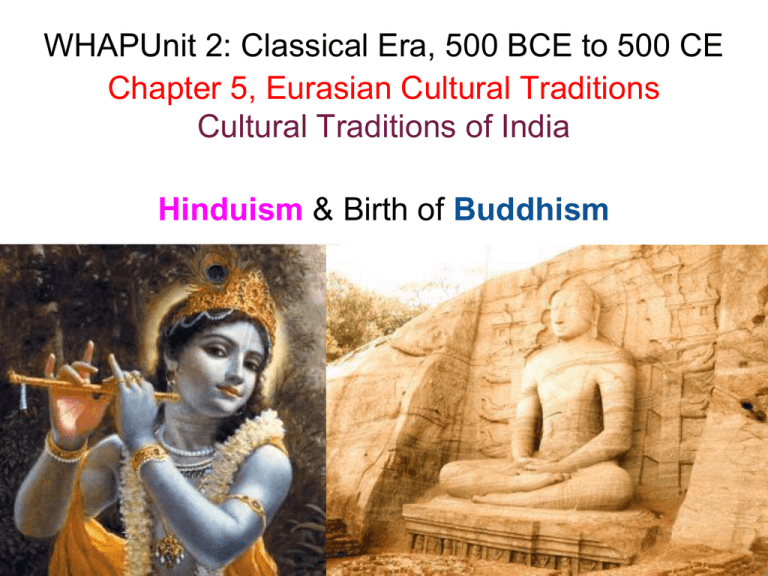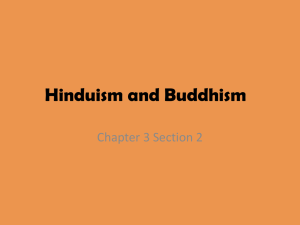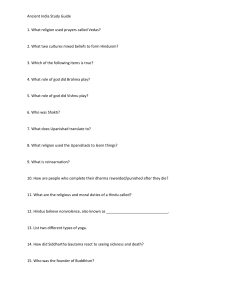WHAP-CH-5-INDIA-CULTURAL-TRADITIONS
advertisement

WHAPUnit 2: Classical Era, 500 BCE to 500 CE Chapter 5, Eurasian Cultural Traditions Cultural Traditions of India Hinduism & Birth of Buddhism Crash Course WH: Buddha & Ashoka Hinduism One of the MOST ancient religions. Dates back to the times of the Indus Valley. No 'founder' - developed over many years and many groups of people very slowly. Problem with life is samsara - wandering through multiple lives Moksha = how you end samsara, pops one out of the cycle of life/death/rebirth. "Big Tent Religion" ★ Most diverse and accommodating of the major religions. ★ Best example is welcoming Buddha has a Hindu incarnation of Vishnu. (Same with Jesus) Religious Texts: Scriptures of the Vedas & Upanishads move to ... The Bhagavad Gita Brahma, Vishnu and Shiva seated on lotuses with their consorts, Saraswati, Lakshmi and Paravati respectively. "The three greatest Hindu deities are shown here together with their consorts. They are sometimes regarded as a trinity, who together represent aspects of the supreme godhead." Caste & Hinduism seem to be intricately connected. Very colorful gods. Many who study Hinduism say there is only truly 1 god = like the trinity (Trimurti—the three aspects of the universal supreme God) Brahma - creator Vishnu - sustained Shivas - destroyer *also women find attractive that there are female gods. Indian Cultural Tradition = Hinduism/Caste System Diversity of gods, spirits, beliefs, practices, rituals, and philosophies. Brahman – “World Soul” the final and ultimate reality (similar to Chinese Dao) Only Brahman was real, not what humans perceive with their senses = illusion. Final goal is to have the atman union with Brahman, called moksha = liberation. Left: Shvetaketu learns about death (from the Chhandogya Upanishad) Bottom & Right: Like water changing form, one can attain moksha or liberation. World Religions: Interview with Stephen Prothero, NY Times Best Selling author. Vedas: Poems, hymns, prayers, & rituals. Compiled by Brahmins. Composed in Vedic Sanskrit, the texts constitute the oldest layer of Sanskrit literature and the oldest scriptures of Hinduism. They are supposed to have been directly revealed and created by Brahma. The Vedic texts are organized around 4 canonical collections of metrical material, of which the first 3 are related to the performance of yajna (sacrifice) in historical Vedic religion: ★ Rigveda: hymns to be recited by the presiding priest; ★ Yajurveda: containing formulas to be recited by the officiating priest; ★ Samaveda: containing formulas to be sung by the priest that chants; ★ Atharvaveda: collection of spells & incantations, apotropaic charms & speculative hymns. Bhagavad Gita “O Krishna, when I see my own people . . . eager for battle, my limbs shudder, my mouth is dry, my body shivers, and my hair stands on end. I can see no good in killing my own kinsmen.” Krishna replied, “Do not despair of your duty. If you do not fight this just battle you will fail in your own law and in your honor.” -From Barbara Keller, ed., The Bhagavad-Gita, 1986. Who is Krishna? How does Krishna respond? Upanishads: Sacred Texts that probed inner meaning of sacrifice described in the Vedas. From the Katha Upanishad: “Higher than the senses are the objects of sense. Higher than the objects of sense is the mind; And higher than the mind is the intellect (buddhi). Higher than the intellect is the Great Self (tman). Higher than the Great is the Unmanifest (avyakta). Higher than the Unmanifest is the Person. Higher than the Person there is nothing at all. That is the goal. That is the highest course.” From Sarvepalli Radhakrishnan and Charles A. Moore, eds., A Source Book in Indian Philosophy, Princeton University Press, 1957. What is the goal? What is the lowest level mentioned? According to the Venn diagram above, which religion claims that a single force governs the universe? 1. Ordinary life is full of suffering. 2. This suffering is caused by our desire to satisfy ourselves. 3. The way to end suffering is to end desire for selfish goals and to see others as extensions of ourselves. 4. The way to end desire is to follow the Middle Path. What causes suffering? How can we end suffering? How does Buddhism compare to Hinduism? Theravada = Teaching of the Elders Was a simplified and more accessible version of Hinduism Buddha as a teacher & model, but not divine. Buddhism more of a philosophy than a religion. How does Buddhism compare to Hinduism? Mahayana = “Great Vehicle” Retained a view of karma through Mahayana version of Buddhism. Bodhisattvas = spiritually advanced and developed people that prolonged their own entry into nirvana to assist others through their suffering. Buddha himself became something of a god. Key Difference Between Mahayana Buddhism & Theravada Buddhism Mahayana Buddhism turned Buddha into a divine figure to whom one offer devotion. Borobudur stupas overlooking a mountain. For centuries, it was deserted Adopting a sophisticated form of Mahayana ("great vehicle") Buddhism from monastic centers in northern and northeastern India, Javanese Buddhists created images of the Buddha as well as of members of the Buddhist pantheon. Tara (pic above left) helps extend the powers of the Buddha-to-be Avalokiteshvara, but she is frequently worshiped as an independent deity- a savior who helps convey the rays of Avalokiteshvara's compassion to the suffering beings of this world. Indian Brahman (concept of the "world soul“) most similar to the Buddhist Nirvana Not THAT Nirvana!







